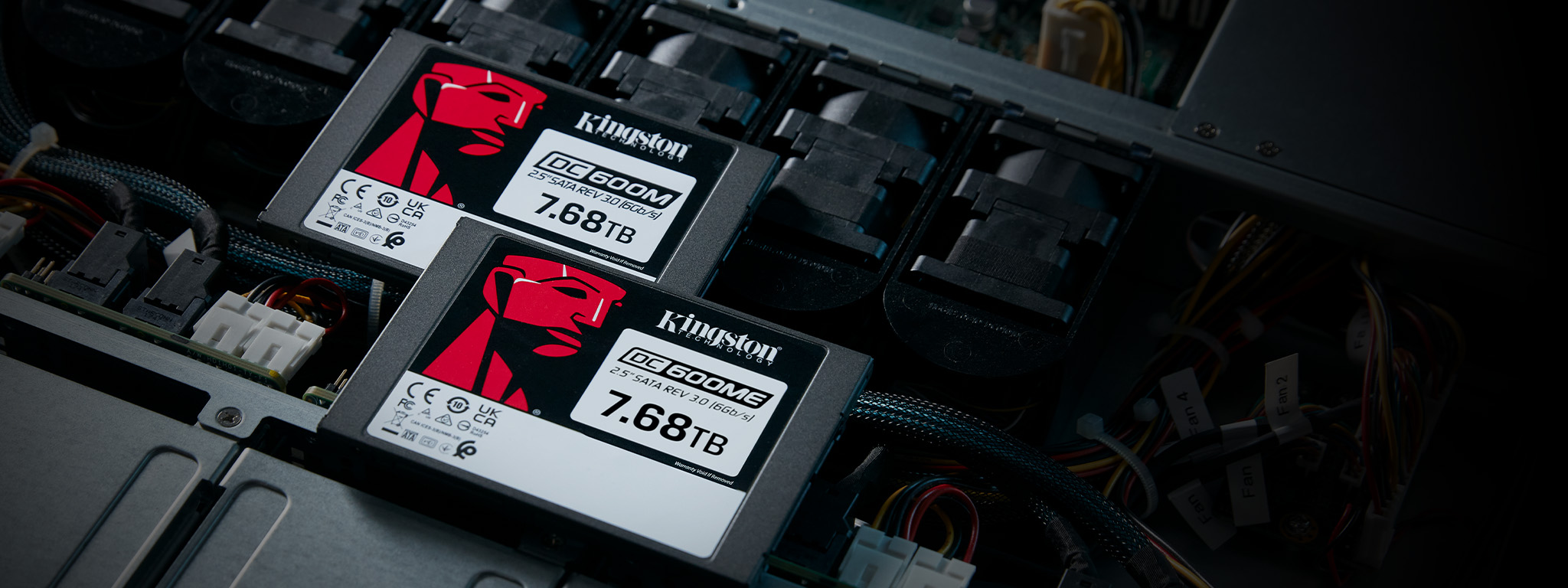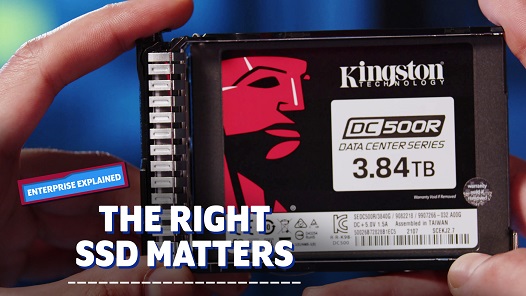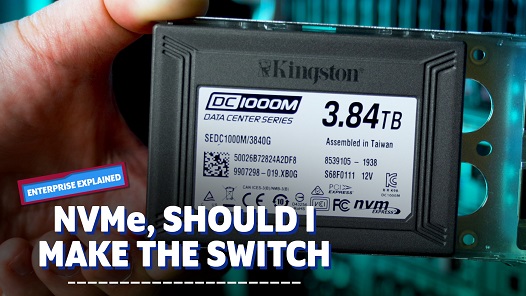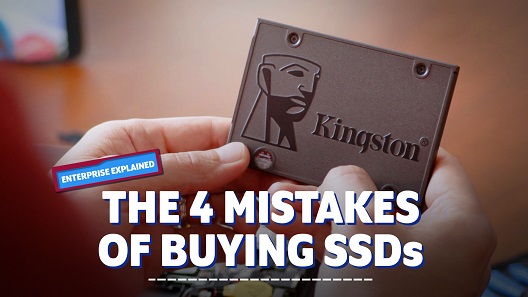Designed for data center environments
Optimised to meet the high demands of server RAID applications with low latency and IO consistency as the key design criteria.

Kingston’s DC600M and DC600ME SSDs are fourth-generation data center SATA 3.0, 6Gbps SSDs utilising 3D TLC NAND intended for “mixed use” server workloads. Both are well suited for a wide variety of server applications and include on-board power loss protection via hold-up capacitors. DC600M and DC600ME are designed to protect data against unexpected power failure and to ensure the drive will successfully reinitialise on the next power-up of the system. Designed to deliver low latency and IO consistency for system integrators, hyperscale data centers and cloud service providers.
DC600ME features AES 256-bit encryption and supports TCG OPAL 2.0 security standards.
Capacities available from 480GB–7.68TB{{Footnote.N37130}} to meet your data storage requirements.

Optimised to meet the high demands of server RAID applications with low latency and IO consistency as the key design criteria.

Power loss capacitors to protect user data against unexpected power loss and enhance performance.

Optimised performance predictability to meet service-level agreements (SLAs).

Protect sensitive data with support for AES 256-bit hardware-based encryption and TCG Opal 2.0 security standards with DC600ME.

Upgrade and manage storage with capacities of up to 7.68TB.{{Footnote.N37130}}
| Form factor | 2.5 inch |
| Interface | SATA Rev. 3.0 (6Gb/s) – with backwards compatibility to SATA Rev. 2.0 (3Gb/s) |
| Capacities{{Footnote.N37130}} | 480GB, 960GB, 1.92TB, 3.84TB, 7.68TB |
| NAND | 3D TLC |
| DRAM Cache | Yes |
| Sequential read/write | 480GB – 560MBs/470MBs 960GB – 560MBs/530MBs 1.92TB – 560MBs/530MBs 3.84TB – 560MBs/530MBs 7.68TB – 560MBs/530MBs |
| Steady-state 4k random read/write | 480GB – 94,000/41,000 IOPS 960GB – 94,000/65,000 IOPS 1.92TB – 94,000/78,000 IOPS 3.84TB – 94,000/59,000 IOPS 7.68TB – 94,000/34,000 IOPS |
| Quality of service (latency){{Footnote.N47723}},{{Footnote.N63075}},{{Footnote.N68899}}(99.999) | Read/Write 480GB – 180/110 uSec 960GB – 3.84TB – 200/300 uSec 7.68TB – 240/170 uSec |
| Typical latency - read/write | <200 µs / <30 us{{Footnote.N47723}},{{Footnote.N63075}},{{Footnote.N68899}} |
| Hot-plug capable | Static and dynamic wear levelling |
| Enterprise SMART tools | Reliability tracking, usage statistics, life remaining, wear levelling, temperature |
| Hardware-based power loss protection | Yes |
| Endurance (TBW) {{Footnote.N63869}} | 480GB – 876TBW, 1 DWPD (5 years), 1.66 DWPD (3 years) 960GB – 1752TBW, 1 DWPD (5 years), 1.66 DWPD (3 years) 1.92TB – 3504TBW, 1 DWPD (5 years), 1.66 DWPD (3 years) 3.84TB – 7008TBW, 1 DWPD (5 years), 1.66 DWPD (3 years) 7.68TB – 14016TBW, 1 DWPD (5 years), 1.66 DWPD (3 years) |
| Power consumption | Idle: 1.30W Average: 1.45W Max read: 1.6W Max write: 3.6W |
| Storage temperature | -40℃ ~ 85℃ |
| Operating temperature | 0℃ ~ 70℃ |
| Dimensions | 69.9mm x 100mm x 7mm |
| Weight | 92.34g |
| Vibration operating | 2.17G Peak (7–800Hz) |
| Vibration non-operating | 20G peak (10–2000Hz) |
| MTBF | 2 million hours |
| UBER | ≤10 -17 |
| Warranty/support | Limited 5-year warranty with free technical support{{Footnote.N68900}} |
| Form factor | 2.5 inch |
| Interface | SATA Rev. 3.0 (6Gb/s) – with backwards compatibility to SATA Rev. 2.0 (3Gb/s) |
| Capacities{{Footnote.N37130}} | 480GB, 960GB, 1.92TB, 3.84TB, 7.68TB |
| NAND | 3D TLC |
| DRAM Cache | Yes |
| Sequential read/write | 480GB – 560MBs/470MBs 960GB – 560MBs/530MBs 1.92TB – 560MBs/530MBs 3.84TB – 560MBs/530MBs 7.68TB – 560MBs/530MBs |
| Steady-state 4k random read/write | 480GB – 94,000/41,000 IOPS 960GB – 94,000/65,000 IOPS 1.92TB – 94,000/78,000 IOPS 3.84TB – 94,000/59,000 IOPS 7.68TB – 94,000/34,000 IOPS |
| Quality of service (latency){{Footnote.N47723}},{{Footnote.N63075}},{{Footnote.N68899}}(99.999) | Read/Write 480GB – 500/130 uSec 960GB - 200/400 uSec 1.92TB – 450/210 uSec 3.84TB - 410/500 uSec 7.68TB – 200/100 uSec |
| Typical latency - read/write | <130 µs / <70 us{{Footnote.N47723}},{{Footnote.N63075}},{{Footnote.N68899}} |
| Hot-plug capable | Static and dynamic wear levelling |
| Enterprise SMART tools | Reliability tracking, usage statistics, life remaining, wear levelling, temperature |
| Hardware-based power loss protection | Yes |
| Endurance (TBW) {{Footnote.N63869}} | 480GB – 876TBW, 1 DWPD (5 years), 1.66 DWPD (3 years) 960GB – 1752TBW, 1 DWPD (5 years), 1.66 DWPD (3 years) 1.92TB – 3504TBW, 1 DWPD (5 years), 1.66 DWPD (3 years) 3.84TB – 7008TBW, 1 DWPD (5 years), 1.66 DWPD (3 years) 7.68TB – 14016TBW, 1 DWPD (5 years), 1.66 DWPD (3 years) |
| Power consumption | Idle: 1.30W Average: 1.45W Max read: 1.6W Max write: 3.6W |
| Storage temperature | -40℃ ~ 85℃ |
| Operating temperature | 0℃ ~ 70℃ |
| Dimensions | 69.9mm x 100mm x 7mm |
| Weight | 92.34g |
| Vibration operating | 2.17G Peak (7–800Hz) |
| Vibration non-operating | 20G peak (10–2000Hz) |
| MTBF | 2 million hours |
| UBER | ≤10 -17 |
| Warranty/support | Limited 5-year warranty with free technical support{{Footnote.N68900}} |

Planning the right solution requires an understanding of your project’s security goals. Let Kingston’s experts guide you.

Choosing the right SSD is important since not all SSDs are alike. When it comes to data centres, choosing an SSD with the right performance consistency with low latencies that’s specifically built for enterprise and data centre workloads is key for consistent and reliable performance.

Cameron Crandall of Kingston helps you decide if you should move to your server storage to NVMe SSDs.

SSDs are all alike, right? You plug it in and instantly have all of that Flash Memory available for your workload? Right? If you answered yes, then you’ve probably fallen to one of the 4 biggest mistakes you could make when selecting your SSD.

Some enterprises still make use of client SSDs to handle high-intensity server tasks, then rip and replace them when they fail to maintain the required standard of performance. Learn why that’s a false economy and how enterprise-level drives can increase organisational efficiency.